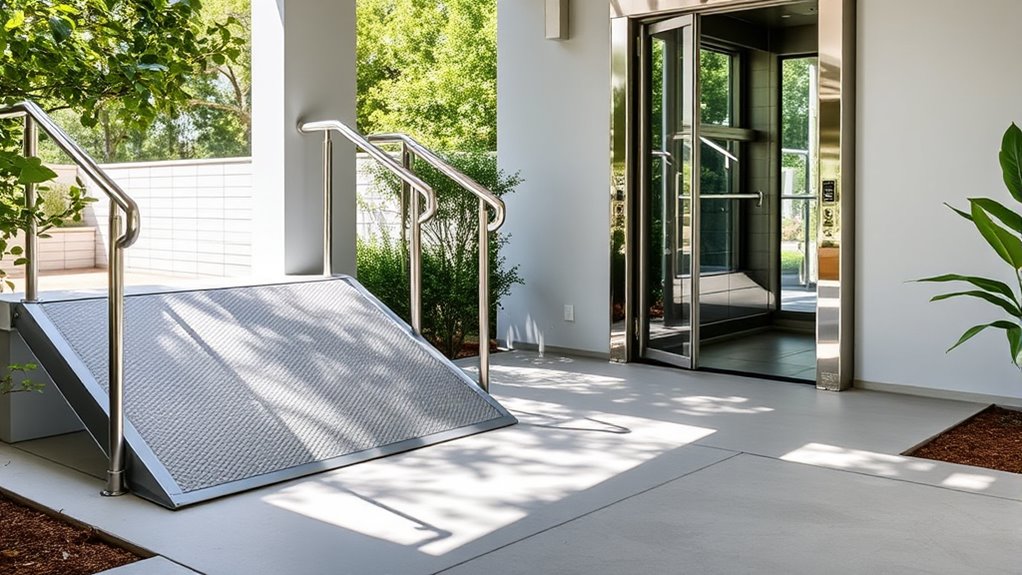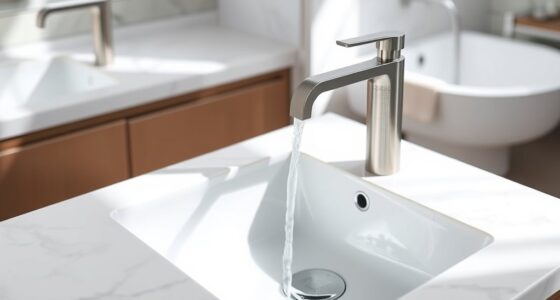When choosing between ramps and lifts for your home, consider your space, budget, and long-term needs. Ramps are affordable, easy to install, and great for outdoor or indoor continuous access, but they require more space. Lifts are space-efficient, offering quick, effortless travel between levels, ideal for limited areas. Your decision depends on balancing initial costs with ongoing maintenance and the convenience that best suits your lifestyle; explore more to find the best fit.
Key Takeaways
- Ramps are cost-effective and easier to install, ideal for outdoor or continuous access needs.
- Lifts save space and are suitable for homes with limited room, providing quick vertical movement.
- Compliance with accessibility standards ensures safety and legal adherence for both ramps and lifts.
- Ramps require more space and slope considerations, while lifts involve higher initial costs but less space.
- Choose based on budget, space availability, user comfort, and long-term mobility needs.

When choosing between ramps and lifts for accessibility, understanding their differences can help you make the best decision for your space. Both options aim to improve mobility, but they vary markedly in design, functionality, and suitability depending on your specific needs. Accessibility standards play an essential role here, as they set the guidelines for safe and effective solutions, whether you opt for a ramp or a lift. These standards specify slope requirements, handrail placements, and clear width, ensuring that whichever you choose provides safe passage for wheelchair users or those with mobility challenges. Knowing these standards helps you select a compliant and reliable option, avoiding future safety issues or legal complications.
Understanding accessibility standards ensures safe, compliant choices between ramps and lifts for your space.
Cost comparison is another critical factor to consider. Ramps are generally more affordable upfront and easier to install, especially if you’re capable of building or installing one yourself. They require minimal maintenance and can be customized in length and material to fit your budget. However, the cost can increase if you need a longer ramp due to space constraints or if you choose high-end materials like aluminum or composite, which provide durability and a sleek appearance. Lifts, on the other hand, tend to have a higher initial investment. Their purchase price includes not only the lift mechanism but also professional installation, electrical work, and possibly structural modifications to your home. While lifts are more expensive initially, they often require less space and can be more comfortable for frequent use, especially in multi-story homes.
When comparing long-term expenses, consider maintenance costs. Ramps, with fewer mechanical parts, typically demand less ongoing upkeep. Lifts, however, require periodic inspections, servicing, and potential repairs, which could add to your expenses over time. Additionally, think about convenience and safety; ramps provide a continuous slope, making them easy to navigate with a wheelchair or walker, but they can take up considerable outdoor or indoor space. Lifts offer quick, effortless travel between levels without taking up much floor space, making them ideal for homes with limited room or for those who prefer a hands-free solution. Moreover, advancements in AI-powered safety features are increasingly incorporated into modern lifts to enhance user security and operational reliability.
Ultimately, your choice hinges on your budget, space, and personal preferences. If affordability and simplicity are priorities, a well-constructed ramp that meets accessibility standards might serve you best. If you need a more space-efficient, user-friendly option and are prepared for a higher investment, a lift could be the better fit. Weighing these factors carefully ensures that you select a solution that enhances safety, meets legal standards, and aligns with your long-term needs.
Frequently Asked Questions
What Are the Cost Differences Between Installing Ramps and Lifts?
When comparing costs, you’ll find that ramps generally cost less upfront than lifts due to lower installation complexity. Ramps are simpler to install and often more discreet, which minimizes aesthetic impact. Lifts require more technical work, making them pricier and potentially more intrusive. Keep in mind, though, that ongoing maintenance costs can also influence your decision, so weigh initial expenses against long-term needs.
How Much Space Does Each Option Require for Installation?
When considering space for installation, ramps generally need more room, especially for a gentle incline, requiring a threshold width of at least 36 inches. Lifts, on the other hand, need a compact area with solid structural support and space for the platform to move. You should measure your entryway carefully, ensuring enough room for a ramp’s slope or a lift’s footprint, while also considering structural support for the lift’s installation.
Are Ramps or Lifts Suitable for Outdoor Use in Various Climates?
Imagine your home as a sturdy boat steering seasonal weather changes. Ramps typically have better weather resistance for outdoor use, handling rain and snow with proper materials. Lifts, however, may require more maintenance and protection against the elements. For outdoor setups across various climates, consider seasonal considerations like freezing temperatures or heavy rain, which can affect lift functionality. Ramps tend to be more reliable in diverse weather conditions, making them a versatile choice.
What Maintenance Is Needed for Ramps Compared to Lifts?
You need to perform routine inspections and follow specific cleaning requirements for both ramps and lifts. Ramps generally require regular debris removal and checking for damage or wear, especially if outdoors. Lifts, on the other hand, need routine inspections of mechanical parts, electrical systems, and lubrication. Both systems benefit from prompt maintenance to prevent issues, but lifts often involve more complex upkeep due to their moving parts.
Which Option Offers Better Long-Term Durability and Safety?
Imagine a sturdy bridge that withstands storms—that’s your home solution. Ramps often have better structural integrity, especially when made from durable materials like concrete or steel, offering longer material longevity. Lifts, while versatile, may face mechanical wear over time, risking safety. So, if you want long-term durability and safety, a well-constructed ramp usually outperforms lifts, just like a reliable bridge endures many seasons.
Conclusion
Think of ramps and lifts as your home’s trusty bridges or magical portals. Ramps are like scenic walkways, inviting you to take steady, natural steps, while lifts are sleek elevators whisking you swiftly upward. Choosing between them is like picking a gentle trail or a quick elevator ride—you’ll want what best fits your journey. Whichever you choose, it’s about creating a smooth path so everyone can reach new heights with ease and confidence.









